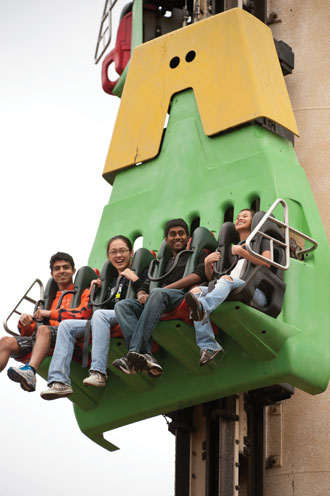At Six Flags America in Upper Marlboro, Md., a team of biomedical engineering students huddles around a bench near Superman: Ride of Steel—a roller coaster that hurtles along over one mile of track at a top speed of 70 mph. You can hear shrill screams in the distance as the roller coaster reaches the precipice of its 20-story, terror-inducing drop.

These freshmen aren’t at the park just for the thrill. They are conducting the annual “roller coaster experiment,“ one of five team-based research projects in the biomedical engineering Freshman Modeling and Design class. The field trip is the highlight of the semester-long course designed to give students a first taste of research. “In Freshman Modeling and Design, our students don’t study science—they make it,” says Professor of Biomedical Engineering Eileen Haase, who has taught the class alongside BME Professor Art Shoukas for 12 years.
For the experiment, students get free rein of the amusement park before it officially opens to collect heart rate and acceleration data on three of the park’s most impressive rides—The Joker’s Jinx, Superman: Ride of Steel, and the Tower of Doom.
While on the rides, students wear a SHARD (Synchronous Heart rate and Acceleration Recording Device) to measure and record their heart rate and acceleration data. Standing near The Joker’s Jinx, Stephen Johannesson lifts his shirt slightly to reveal a small, blinking box strapped around his waist. He explains that the SHARD is synched with a polar heart rate monitor attached to his chest.
Suddenly, The Joker’s Jinx blasts off with a roar. Johannesson and other students waiting on the platform cover their ears, many laughing. One student excitedly yells, “Oh yeah, I’m getting on that ride!” Others appear apprehensive about riding the Joker’s Jinx, not once but three times to complete the experiment. “The heart actually stops from the sudden force of acceleration,” says Shoukas, offering little consolation to the nervous students. Shoukas pioneered the design-team approach to teaching biomedical engineering at Johns Hopkins.
Freshman Tom Bernstein says Superman is his favorite roller coaster. “Just before the drop is the most exciting part,” he says, predicting that data collected on this ride will reveal a peak in heart rate from sheer anticipation, independent of external forces.
Classmate Gabriela Frid predicts what happens next: “As the roller coaster plummets, heart rate will drop as body pressure drops, followed by a sudden increase in heart rate when the roller coaster reaches the bottom.”
At the Tower of Doom, a free-fall from 140 feet, another group of students is downloading data from a SHARD device to a laptop. The experiment is going according to plan, according to freshman Inez Lan. “The most important thing is communication with your team. You have to make sure the SHARD is properly calibrated, and that the device is on and collecting data.”
According to Haase, students learn more than physics and physiology from the roller coaster experiment. “Students learn to form a hypothesis, to develop an experiment, and to work as a team to solve research problems, whether in the lab or on a roller coaster.”




